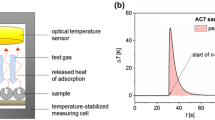Abstract
The kinetics of the reaction o2 oxygen with a sucrose char particle size: (88 μ<dp<105 μrn) has been studied using a thermogravimetric analyzer (TGA) and a mass spectrometer (MS) to measure weight change and CO and CO2 formation rates during reaction. Experiments were performed to determine the surface oxide formation rate and to determine the mechanism of CO desorption in the temperature range of 762 K to 851 K and for oxygen pressures of 0.04 to 0.3 atm, respectively. When the reaction rate at 30% conversion was used in the Arrhenius plot, an activation energy of 34±3 kcal/mol was obtained and the CO/CO2 ratio was found to increase with increasing reaction temperature. Analysis of the rate of formation of CO and CO2 shows the activation energy for CO formation is greater than for CO2 formation. Temperature programmed desorption (TPD) studies of the surface oxides were made to provide a better understanding of the carbon oxidation process. The activation energy distribution function for desorption was approximately Gaussian and the average activation energy is 55 Kcal/mol for a preexponential factor of 1013 1/sec. The peak of the energy distribution function shifts to higher activation energies for surface complexes formed at higher reaction temperature.
Similar content being viewed by others
References
Calo, J. M. and Hall, P. J., “A Mathematical Model of Temperature Programmed Desorption of Oxygen Complexes from Porous Chars and Carbons”,ACS Division of Fuel Chemistry preprints,34(1), 71 (1989).
Du, Z., Sarofim, A. F. and Longwell, J. P., “Activation Energy Distribution in Temperature-Programmed Desorption: Modeling and Application to the Soot-Oxygen System”,Energy and Fuels,4, 296 (1990).
Du, Z., Sarofim, A. F. and Longwell, J. P., “Kinetic Measurement and Modeling of Carbon Oxidation”,Energy and Fuels,5, 214 (1991).
Floess, J. K., Lee, K.-J. and Oleksy, S. A., “Kinetics of Oxygen Chemisorption on Microporous Carbons”,Energy and Fuels,5, 133 (1991).
Hall, P. J., Calo, J. M., Teng, H., Suuberg, E. M., May, J. A. and Lilly, W. D., “The Nature of Carbon-Oxygen Complexes Produced by Different Oxidants: Towards a Unified Theory of Gasification”,ACS Division of Fuel Chemistry preprints,34(1), 112 (1989).
Hall, P. J. and Calo, J. M., “Energetic Distribution of Oxygen Surface Complexes on Porous Carbons and Chars”,ACS Division of Fuel Chemistry preprints,35(3), 689 (1990).
Lizzio, A. A. and Radovic, L. R., “Kinetics of Carbon Gasification”,ACS Division of Fuel Chemistry preprints,34(1), 102 (1989).
Suuberg, E. M., “Approximate Solution Technique for Nonisothermal, Gaussian Distributed Activation Energy Models”,Combustion and Flame,50, 243 (1983).
Author information
Authors and Affiliations
Rights and permissions
About this article
Cite this article
Lee, K.J., Son, S.S. Temperature programmed desorption technique to predict the carbon oxygen reaction. Korean J. Chem. Eng. 12, 251–257 (1995). https://doi.org/10.1007/BF02705654
Received:
Accepted:
Issue Date:
DOI: https://doi.org/10.1007/BF02705654




